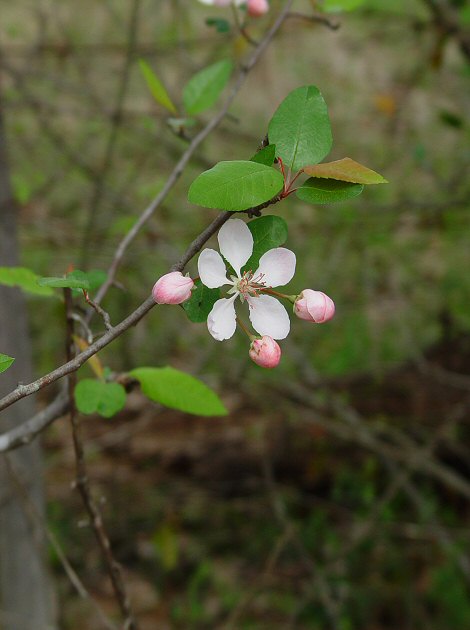Malus angustifolia (Aiton) Michx.
Wild Crab

Native
CC = 10
CW = 5
MOC = 6
SRank = S2
© DETenaglia
Malus angustifolia (Aiton) Michx.Wild Crab | |
 |
Native CC = 10 CW = 5 MOC = 6 SRank = S2 |
© DETenaglia |
|
Family - Rosaceae Stems - A small tree to 10m tall. Trunk to 30cm in diameter. Bark thin (-1cm thick), scaly, narrowly ridged, reddish-brown to brownish-gray. Older twigs with round lenticels, grayish-brown. New season's growth tomentose but quickly becoming glabrate. Previous season's twigs frequently tapering to a point and forming "thorns."
Leaves - Alternate, petiolate, tomentose when new but quickly glabrate. Petioles pilose, to +1.5cm long, frequently with a pair of linear stipules at the base. Stipules to 2mm long. Petioles with an adaxial groove. Blades ovate-lanceolate, crenate to crenate-serrate, green above, lighter below, with a few reddish glands on the midrib adaxially, to +6cm long, +3cm broad, blunt to acute at the apex.
Inflorescence - 1-4 flowers terminating new season's growth. Pedicels to +/-2cm long, sparse to densely pubescent (pilose), green and reddish-green.
Flowers - Petals 5, spreading, pink to white, clawed, 2-2.5cm long total, +/-1cm broad (blade), rounded at the apex. Blade mostly glabrous, claw pilose and with pilose margins. Claw +/-5mm long. Margins of blade slightly erose. Stamens +/-20, well exserted, erect, borne at the apex of the hypanthium. Filaments to +/-1.3cm long, pink to white, glabrous. Anthers yellow to brown, 2mm long. Pollen yellow. Styles 5, borne at the base of the hypanthium, +/-1.3cm long, densely pilose in the basal 1/3, glabrous above, slightly expanded below the stigmas, translucent-white. Stigmas capitate, small. Ovary inferior, 5-carpellate, with 10 ovules. Hypanthium green, glabrous internally and externally, 3-4mm long, campanulate to cupulate, +2mm in diameter. Sepals 5, mostly glabrous and green externally, tomentose internally, subulate, 3-5mm long, to 2mm broad at the base, apiculate.
Flowering - April - May. Habitat - Lowland and upland woods and thickets of the Crowley Ridge. Also cultivated. Origin - Native to U.S. Other info. - This showy species is rare in Missouri and can be found wild in just one county from the bootheel of the state. It is much more common in cultivation and wild in states to the south and east. The plant can be identified by its ovate-lanceolate leaves, glabrous pedicels and hypanthia, whitish-pink flowers, and small fruits. Photographs taken somewhere in south Alabama, 3-18-06. |